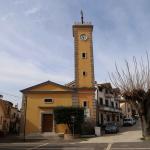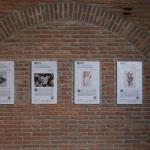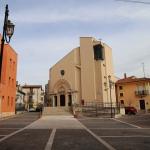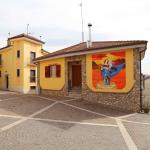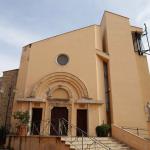The Municipality of Villamaina is located in Calore Valley area, close to Upper Irpinia. It's a town with 963 inhabitants, located 560 metres above sea level, at 40 km from Avellino. The territory extends for 9.04 sq km and the adjoining municipalities are: Frigento, Gesualdo, Paternopoli, Rocca San Felice, Sant'Angelo dei Lombardi and Torella dei Lombardi. It's crossed by the Fredane river and the Conche stream.
The etymology of the name probably derives from "villa" in the sense of latifundium and "magna", that is large: over time the word "magna" has been transformed into "maina". The inhabitants are called Villamainesi and Saint Roch and Saint Paulinus of Nola are their patron saints.
PLACES OF INTEREST
- San Teodoro Thermal Baths - Ancient thermal baths that date back to the second half of the 17th century and which today, thanks to the mineral-rich waters and the many wellness programs, attract many tourists for a relaxing stay
- Municipal Museum Collection of Villamaina - Exhibition that includes prehistoric fragments, precious elements of the Samnite age, important evidence of the Roman period, up to materials of the modern age
- Municipal Park Giovanni Gussone - Dedicated to the botanist from Villamaina Giovanni Gussone: it includes a five-a-side football or basketball court, a bowling green, tree-lined avenues, mostly with medium and large olive trees, as well as a small outdoor amphitheatre
- Rocca woods - Small woods, located near the Mefite locality, halfway between the municipalities of Villamaina and Rocca San Felice, composed of brambles, holly, gorse and tall trees, mainly oaks, elms and poplars
- Churches - Mother church of S. Maria della Pace (Our Lady of Peace), Church of S. Antonio (Saint Anthony), Church of S. Maria del Carmine (Saint Mary of Mount Carmel), Church of S. Maria di Costantinopoli (Our Lady of Constantinople) and Church of S. Rocco (Saint Roch)
- Source of Formulano - Ancient source of historical value, dating back to Roman times: in the 19th century, the remains of ancient Roman buildings were found, with mosaic floors
- Ancient Water Mills - Four vertical axis and horizontal wheel mills: Mulino Isca, Mulino Fontanelle, Mulino di Sotto le Coste and Mulino Conche: only the latter is restored and visible in Le Conche di Villamaina
EVENTS
- Feast of Saint Anthony and Saint Paulinus - Celebrations that take place on the 21st and 22nd of June, in honour of the patron saints Paulinus of Nola and Anthony: for the occasion, there is also a procession through the town with the statues of the saints and the music band
- Feast of Saint Joseph - Feast held on the 19th of March with lighting of bonfires, music and local food and wine
- Pilgrimage to the church of SS. Giovanni e Paolo (Saint John and Paul) - Celebration held at the end of May with the procession from Villamaina to the Church, located not far from the Girifalco woods, in Torella Lombardi
TYPICAL FOOD AND PRODUCTS
- Ricotta di Carmasciano PAT - White, with a soft and creamy consistency, obtained from the residual whey from the processing of the homonymous pecorino, very valuable
- Irpinia Colline dell'Ufita PDO - Extra virgin olive oil deriving largely from the Ravece variety, characterized by a pleasant bitter and spicy taste
- Menesta maritata - Typical Irpinian dish, whose name derives from the fact that the ingredients of meat and vegetables are put together, "married"
- Pizza jonna - Pizza made with corn flour
- Fresh handmade pasta - Fusilli, ravioli, tagliatelle, "laghene", cavatelli, maccaronara
- Caciocavallo irpino di grotta PAT - Spun curd cheese, produced with milk from small and medium-sized farms, mainly from brown cattle, traditionally aged in caves
FUN FACTS
Originally, on the top of the hill on which Villamaina stands, there were no springs: the water, therefore, was transported from the sources located downstream with pack animals, or carried by the same people, using large jars resting on their heads.
After the arrival of electricity in the 1920s, an electric pump was installed at the source of Formulano and, thanks to some donations from Villamaina citizens residing in America, three public fountains were built in the town.
HISTORICAL NOTES
The numerous archaeological finds found not only in the municipal area, but also in the neighbouring ones, suggest that the origins of Villamaina are very ancient, as evidenced also by its proximity to the ancient Appian Way.
In Norman times, belonged to the Barony of Frigento. Subsequently, it became a fiefdom, administered first by the Gesualdo, then by the Caracciolo family: the latter governed Villamaina until the abolition of feudalism in 1806, with the title of "barons" and "dukes of San Teodoro".
The Villamaina community has been upset, in the course of history, by some mournful events, such as the plague epidemic of 1656 which decimated the local population and the earthquake of the 23rd of November 1980 which caused considerable damage to the buildings located in the town, characterized by a modern look today.
Visiting Villamaina represents the ideal opportunity to keep fit and regain well-being or simply to have fun among the mysteries of the goddess Mefitis
Villamaina
Via Roma, 77, 83050 VIllamaina AV, Italia
Events
On November 25, 2023, the historical figure and the scientific legacy of the illustrious…
On January 6, 2025, the Old Lady will distribute gifts to young and old
Featured places
Via Bagni, 20, 83050, Villamaina AV, Italia
Set in an area of natural beauty with a favourable climate almost all year round, the historic…
Via Roma, 77 83050, VIllamaina AV, Italia
A repertoire of evidence of a very ancient past, the Museum Collection of the Municipality of…
Via Pianello, 83050, Villamaina AV, Italia
Dedicated to the memory of the botanist Giovanni Gussone, a prominent figure in the last…
Did you like it? Leave a review
Your opinion is important! It will be visible after approval by the editorial staff.
To post a comment you must be an authenticated user. Log in with Social Login
